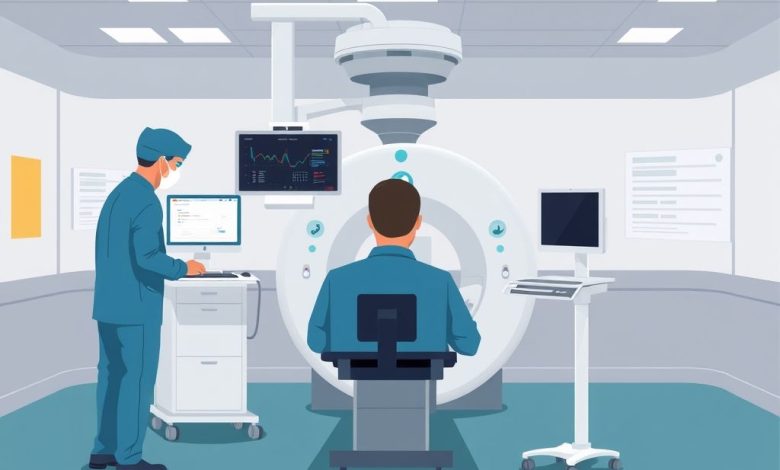Field Service Management for Medical Imaging Equipment Optimizing Maintenance and Support

Introduction
Field Service Management (FSM) has become increasingly crucial in the healthcare industry, particularly for managing medical imaging equipment. Medical imaging technologies such as X-ray machines, MRI scanners, and CT scanners require regular maintenance and occasional repairs to ensure optimal performance and patient safety. Effective FSM strategies have transformed how healthcare providers manage their diagnostic equipment, improving efficiency, reducing downtime, and enhancing overall patient care.
- The Importance of Field Service Management in Medical Imaging
- Key Components of Field Service Management Systems for Medical Imaging Equipment
- 1. Scheduling and Dispatch
- 2. Inventory Management
- 3. Work Order Management
- 4. Reporting and Analytics
- 5. Integration with Other Systems
- Best Practices for Implementing Field Service Management in Medical Imaging Equipment Maintenance
- Challenges in Field Service Management for Medical Imaging Equipment
- Future Trends in Field Service Management for Medical Imaging Equipment
- Conclusion
The Importance of Field Service Management in Medical Imaging
Medical imaging equipment plays a vital role in modern healthcare. These devices enable doctors to visualize internal structures of the body, diagnose conditions, and monitor treatment progress. However, maintaining this equipment requires specialized knowledge and expertise. Field service management systems have emerged as essential tools for healthcare organizations to streamline their equipment maintenance processes.
Benefits of Implementing FSM for Medical Imaging Equipment
- Improved Efficiency: FSM software automates scheduling, dispatching, and tracking of service requests, reducing administrative overhead and allowing technicians to focus on critical tasks.
- Enhanced Customer Satisfaction: Real-time updates and transparent communication with customers lead to higher satisfaction rates and stronger relationships between healthcare providers and patients.
- Reduced Downtime: Proactive maintenance schedules and quick response times minimize equipment downtime, ensuring continuous diagnostic capabilities.
- Cost Savings: Optimized routes and efficient scheduling reduce travel time and associated costs, while predictive maintenance helps extend equipment lifespan.
- Data-Driven Decision Making: FSM systems provide valuable insights into equipment performance, usage patterns, and maintenance history, enabling data-driven decisions for future investments and upgrades.
Key Components of Field Service Management Systems for Medical Imaging Equipment
Modern FSM solutions for medical imaging equipment typically include several essential modules:
1. Scheduling and Dispatch
This module automates the process of assigning service requests to available technicians based on their location, skill level, and workload. Advanced scheduling algorithms ensure optimal route planning, minimizing travel time and reducing overall response times.
2. Inventory Management
Proper inventory control is critical for maintaining medical imaging equipment. FSM systems track spare parts, consumables, and accessories, ensuring that necessary items are always available when needed.
3. Work Order Management
This component allows technicians to document their activities, report issues, and request additional support when required. It also facilitates communication between field staff and office personnel.
4. Reporting and Analytics
FSM software provides detailed reports on equipment performance, technician productivity, and customer feedback. These insights enable continuous improvement of service delivery and strategic decision-making.
5. Integration with Other Systems
To maximize efficiency, FSM systems often integrate with other healthcare IT platforms such as electronic health records (EHRs) and picture archiving and communication systems (PACS). This integration enables seamless sharing of patient information and diagnostic images.
Best Practices for Implementing Field Service Management in Medical Imaging Equipment Maintenance
To ensure successful implementation and maximum benefits from FSM systems, healthcare organizations should follow these best practices:
- Conduct thorough needs assessment: Identify specific requirements and pain points unique to your organization before selecting a FSM solution.
- Provide comprehensive training: Ensure that all staff members understand the new system and their roles within it.
- Start small: Begin with a pilot program for a subset of equipment or locations before expanding to the entire fleet.
- Regularly update and maintain the system: Keep the FSM software up-to-date with the latest features and security patches.
- Foster a culture of continuous improvement: Encourage feedback from both technicians and customers to continually refine the service delivery process.
Challenges in Field Service Management for Medical Imaging Equipment
Despite the numerous benefits, implementing FSM systems for medical imaging equipment comes with several challenges:
- Complexity of equipment: Medical imaging devices require specialized knowledge, making it challenging to train technicians on their operation and maintenance.
- Regulatory compliance: FSM systems must adhere to strict healthcare regulations, such as HIPAA, ensuring secure handling of patient data.
- High-value assets: The cost of medical imaging equipment means that downtime and damage must be minimized at all costs.
- Remote diagnostics: While FSM systems often include remote diagnostic capabilities, some issues may still require on-site visits, complicating scheduling and dispatch processes.
Future Trends in Field Service Management for Medical Imaging Equipment
As technology continues to evolve, we can expect several trends to shape the future of FSM in medical imaging:
- Artificial Intelligence (AI) Integration: Predictive maintenance algorithms powered by AI will become more prevalent, allowing for proactive rather than reactive maintenance strategies.
- Internet of Things (IoT): Connected medical imaging equipment will provide real-time data on usage patterns and performance metrics, enabling more efficient service planning.
- Augmented Reality (AR): AR technologies will enhance remote diagnostics, allowing technicians to visualize and interact with equipment remotely.
- Blockchain: Secure sharing of equipment history and maintenance records without intermediaries will improve transparency and accountability.
Conclusion
Field Service Management has revolutionized the way healthcare organizations maintain medical imaging equipment. By implementing FSM solutions, providers can significantly improve efficiency, reduce costs, and enhance patient care. As technology continues to advance, FSM systems will become even more sophisticated, enabling healthcare providers to focus on what matters most – delivering high-quality diagnostic services to patients in need.
By embracing FSM strategies tailored to medical imaging equipment, healthcare organizations can ensure that their diagnostic capabilities remain cutting-edge while maintaining the highest standards of patient safety and care.




